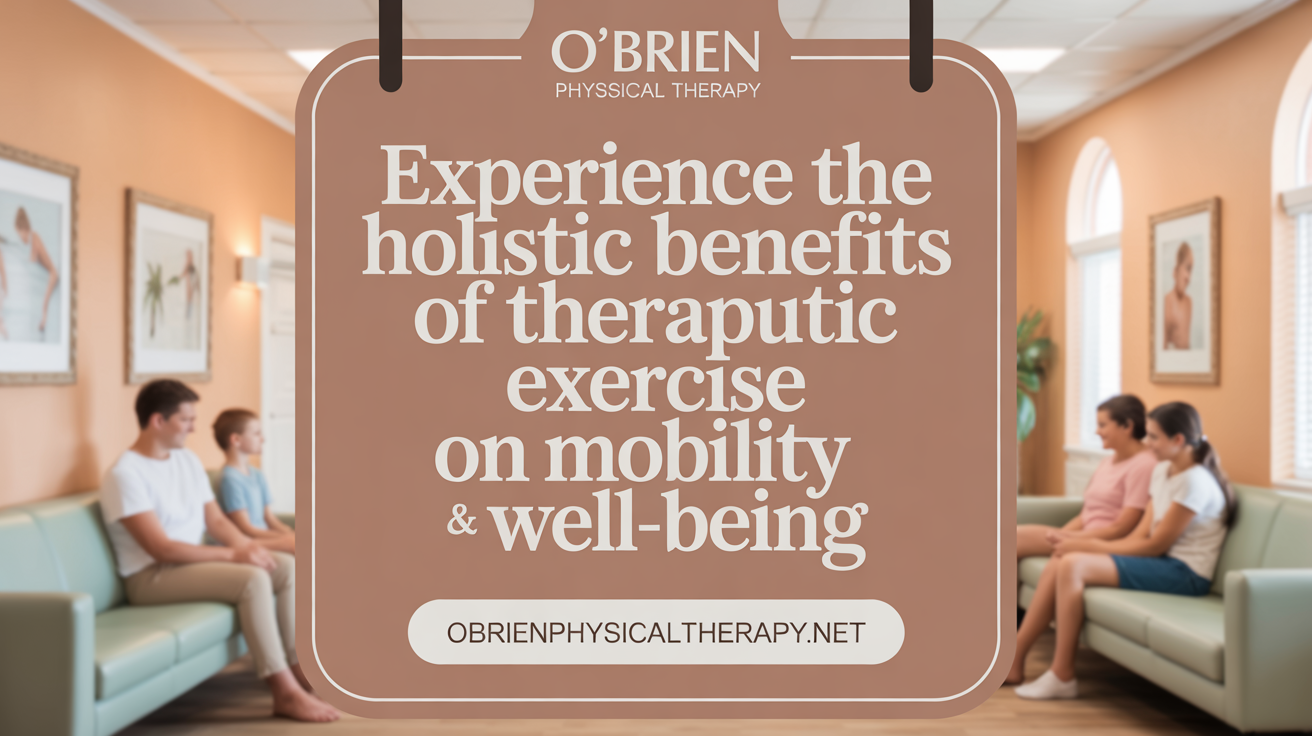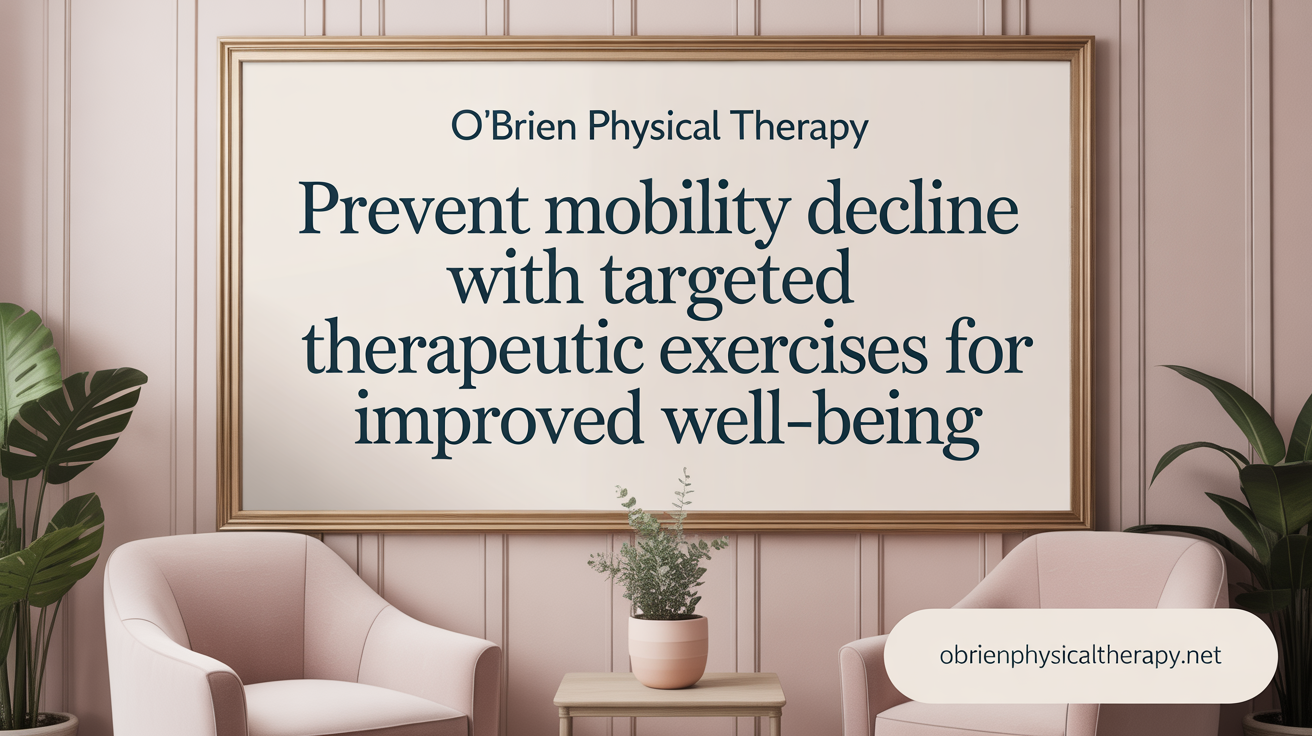Understanding the Importance of Therapeutic Exercise for Mobility
Therapeutic exercise is a specialized, evidence-based approach within physical therapy that plays a crucial role in maintaining and improving long-term mobility. As people age or recover from injury or illness, preserving the ability to move with strength, balance, and confidence is essential to sustaining independence and quality of life. This article explores the multifaceted benefits of therapeutic exercise, its key techniques, and its importance in preventing mobility decline over time through personalized, targeted interventions designed to restore function and promote well-being.
Comprehensive Benefits of Therapeutic Exercise for Long-Term Mobility

What are the benefits of therapeutic exercise for long-term mobility?
Therapeutic exercise provides a wide range of advantages that significantly contribute to maintaining and enhancing long-term mobility. It helps improve muscle strength and endurance, which are essential for supporting joints and enabling easier movement. By including flexibility, balance, and coordination exercises, therapeutic programs assist in reducing the risk of falls—a critical consideration, especially in older adults.
These exercises also enhance joint function by promoting proper alignment and movement patterns. Effective pain reduction is another major benefit, often achieved through targeted stretching, manual therapy, and strengthening exercises that alleviate stiffness and discomfort.
Management of chronic health conditions, such as osteoarthritis, diabetes, and cardiovascular diseases, is supported by regular therapeutic activity. Such exercises improve overall cardiovascular and respiratory capacity, as indicated by measurements like VO2 max, which reflects aerobic endurance.
Furthermore, engaging in therapeutic exercise can foster mental wellness, reduce anxiety, and improve metabolic health. This holistic approach contributes to better sleep, increased energy levels, and a sense of independence.
Importantly, the positive impacts of individualized therapeutic exercise routines can last long after ceasing formal training, often extending several months. This enduring effect underscores the importance of consistent participation in appropriately tailored programs. Guided by licensed professionals, these exercises form a crucial part of strategies aimed at preserving mobility, preventing injuries, and fostering a healthier, more active lifestyle.
Physical Therapy: A Cornerstone for Preserving and Enhancing Mobility

How does physical therapy support the preservation of long-term mobility?
Physical therapy plays a vital role in helping individuals maintain their ability to move freely and comfortably over time. It offers personalized, noninvasive methods that specifically target each person's unique needs and challenges.
Therapists utilize targeted exercises and treatments that strengthen muscles, improve joint flexibility, and enhance balance and coordination. These interventions are crucial for preserving mobility, especially as people age or recover from injuries.
Rehabilitation after incidents like injuries, surgeries, or strokes is another essential aspect of physical therapy. It helps restore movement, rebuild strength, and regain independence. Additionally, physical therapy supports chronic disease management by encouraging activity that improves cardiovascular health and metabolic function.
Educational components are also incorporated, teaching self-care techniques and injury prevention strategies. This combination of tailored treatment plans and ongoing guidance promotes long-term movement health.
By focusing on functional improvements and preventing future impairments, physical therapy helps individuals sustain their mobility and quality of life, empowering them to stay active and independent even with advancing age or ongoing health conditions.
Long-Term Health Advantages Associated with Consistent Physical Therapy

What are the long-term health advantages associated with physical therapy?
Physical therapy provides a range of benefits that extend beyond immediate symptom relief, supporting sustained health and well-being. One significant advantage is the improvement of posture. Proper alignment results from correcting muscle imbalances and strengthening weak areas, which not only enhances appearance but also boosts lung capacity. Better posture allows the lungs to expand more fully, improving breathing efficiency and oxygen intake over time.
Another notable benefit is fall risk reduction, especially among the elderly. Physical therapists assess balance, strength, and coordination, creating personalized exercise programs that improve stability. This proactive approach helps prevent falls — a common cause of injury and loss of independence in older adults.
In injury prevention and athletic performance, physical therapy plays a vital role. By identifying muscle imbalances and movement dysfunctions, therapists design tailored exercises that strengthen supporting muscles, enhance flexibility, and optimize mechanics. Athletes benefit from these interventions to improve performance and minimize the risk of sports-related injuries.
Chronic pain management is also a critical aspect of long-term health. Physical therapists educate patients on safe movement patterns, activity modifications, and pain-relief techniques such as manual therapy and therapeutic exercises. These strategies help reduce dependence on medications and contribute to sustained pain relief, thereby improving daily function.
Furthermore, physical therapy offers pelvic health improvements. Conditions like urinary incontinence, pelvic pain, and pelvic floor dysfunction can significantly impact quality of life. Specific exercises, education, and sometimes specialized modalities help strengthen pelvic muscles, alleviate symptoms, and restore confidence and comfort.
Overall, engaging in consistent physical therapy supports a healthier lifestyle by promoting proper movement, reducing injury risks, managing chronic conditions, and enhancing bodily functions. These cumulative benefits contribute to an increased quality of life and healthier aging process.
Preventing Mobility Decline Through Therapeutic Exercise: Aging and Injury Considerations

Why is therapeutic exercise important in preventing mobility decline due to aging or injury?
Therapeutic exercise plays a crucial role in maintaining and improving mobility, especially as people age or recover from injuries. As individuals grow older, they naturally experience muscle loss, a condition called sarcopenia, which can impair strength, flexibility, and balance. These declines increase the risk of falls, injuries, and loss of independence.
Research indicates that engaging in targeted exercises significantly reduces fall risk and enhances physical function in older adults. For example, strength training helps rebuild muscle mass, while flexibility and balance exercises improve joint mobility and stability. Programs designed to improve walking speed, coordination, and range of motion have shown to help seniors stay active and independent.
Physical therapists develop personalized plans that incorporate exercises like resistance training, stretching, and balance activities. These not only prevent injury but also empower individuals to manage chronic conditions such as arthritis or osteoporosis. Evidence from systematic reviews and large studies confirms that regular participation in these activities reduces falls, fall-related injuries, and the progression of mobility limitations.
Maintaining mobility through therapeutic exercise supports overall health, reduces the need for long-term care, and enhances quality of life. It enables older adults to perform daily activities like dressing, cooking, and walking safely, fostering independence and confidence.
In essence, consistent therapeutic exercise tailored to individual needs helps preserve physical function, prevents disability, and promotes healthy aging, making it an essential component of preventative health care for aging and injured populations.
Key Techniques and Strategies of Therapeutic Exercise for Sustained Mobility

What techniques and strategies does therapeutic exercise use to aid long-term mobility?
Therapeutic exercise employs a diverse set of techniques designed to help individuals maintain or improve their movement abilities over time. Central to these are resistance training, flexibility and stretching exercises, balance and coordination activities, and endurance or aerobic conditioning.
Resistance training involves strengthening muscles through activities like using resistance bands, weights, or body weight exercises. These help improve muscle strength and joint stability, which are essential for safe, functional movement. Flexibility exercises, including static and dynamic stretches as well as proprioceptive neuromuscular facilitation (PNF), aim to increase joint range of motion and reduce stiffness.
Balance and coordination activities are crucial in preventing falls and enhancing neuromuscular control. Examples include standing on balance pads, Tai Chi, and specific postural exercises that improve stability and sensory integration.
Endurance and aerobic conditioning, such as walking, cycling, or swimming, boost cardiovascular health, stamina, and overall energy levels, enabling sustained activity.
In addition to active exercises, manual therapy techniques—like joint mobilizations, soft tissue manipulation, and patient education—play a vital role in optimizing movement and preventing injury. Educating patients on proper movement mechanics, posture, and activity modifications supports continuous self-care.
The use of assistive devices, such as canes and braces, complements exercise interventions when needed, providing support and safety during mobility practice.
Aquatic therapy offers a low-impact environment for exercising, making it suitable for those with joint pain or limited mobility. The buoyancy of water lessens weight on joints, allowing for more effective and less painful movements.
Personalized, progressive programs are fundamental. Therapists tailor exercises to individual capabilities and gradually increase difficulty to challenge the body appropriately. Consistent practice, along with proper technique and ongoing assessment, ensures improvements are sustained.
Together, these strategies foster the development of strong, flexible, and well-coordinated movement patterns, facilitating long-term independence and quality of life. Regular engagement in these targeted exercises helps individuals overcome limitations, prevent future injuries, and maintain mobility across their lifespan.
Sustaining Mobility: The Broader Impact of Therapeutic Exercise on Quality of Life
How does therapeutic exercise influence emotional and psychological well-being?
Regular engagement in therapeutic exercise has been shown to boost mood, reduce anxiety, and improve sleep quality. Movement and physical activity release endorphins, which are natural mood lifters, and help reduce stress, fostering a sense of well-being.
How does therapy help restore confidence and independence?
As individuals regain strength, mobility, and control over their bodies through tailored exercises, their confidence in performing daily activities improves. This increased independence supports emotional health and motivates continued participation in health-promoting activities.
In what ways does movement aid in pain management?
Movement strategies prescribed during therapy help alleviate pain by reducing stiffness, improving joint function, and promoting tissue healing. Proper exercise techniques can also decrease reliance on medication, supporting safer, long-term pain control.
What role does social and motivational support play?
Physical therapy often involves guided sessions with professionals and sometimes group exercises. This social element provides encouragement, accountability, and emotional support, making it easier to stay committed to long-term health routines.
How does therapeutic exercise contribute to long-term health?
Consistent practice of therapeutic exercises supports overall health by improving cardiovascular function, muscle endurance, flexibility, and metabolic health. These benefits help prevent future injuries and chronic conditions, maintaining mobility well into older age.
How can therapy be integrated into daily lifestyle changes?
Incorporating simple mobility and strength exercises into daily routines—such as stretching in the morning or walking after meals—can reinforce gains made during therapy. Educating patients on functional movements helps sustain their benefits beyond formal sessions.
| Benefit Area | Impact Description | Supporting Details |
|---|---|---|
| Emotional health | Reduced stress, improved mood | Endorphin release, anxiety reduction |
| Confidence & independence | Enhanced self-reliance, greater mobility | Restored ability to perform daily tasks |
| Pain management | Decreased stiffness, improved joint function | Movement reduces inflammation, tissue healing |
| Social support | Motivation, accountability | Professional guidance and group exercises |
| Long-term health | Prevents age-related decline, chronic disease risk | Cardiovascular, metabolic, musculoskeletal improvements |
| Lifestyle integration | Ongoing activity, healthy habits | Simple daily exercises, activity education |
Fostering these aspects ensures that therapeutic exercise benefits extend beyond the clinic, leading to a higher quality of life and sustained mobility over time.
Embracing Therapeutic Exercise for Lifelong Mobility and Well-Being
Therapeutic exercise, guided by skilled physical therapists, is a cornerstone in preserving and enhancing long-term mobility. Its comprehensive benefits span physical, metabolic, and psychological domains, empowering individuals to maintain independence, reduce pain, and prevent future injuries. By embracing personalized, consistent exercise regimens and leveraging a variety of targeted techniques and strategies, people of all ages — especially those managing chronic conditions or recovering from injuries — can foster lifelong movement health and improved quality of life. Ultimately, therapeutic exercise represents a proactive approach to sustaining mobility and well-being that can transform health outcomes across the lifespan.
References
- Physical therapy: 4 benefits that go beyond better mobility
- The Benefits of Therapeutic Exercise - AliMed
- Therapeutic Exercise - StatPearls - NCBI Bookshelf
- Restore Mobility with Therapeutic Exercise
- Top 10 Key Benefits of Physical Therapy - Movement for Life
- 5 Reasons Why Physical Therapy is Vital for Your Recovery
- Physical Therapy (Physiotherapy): What It Is & Benefits
- How Physical Therapy Can Improve Mobility | BioMotion PT
